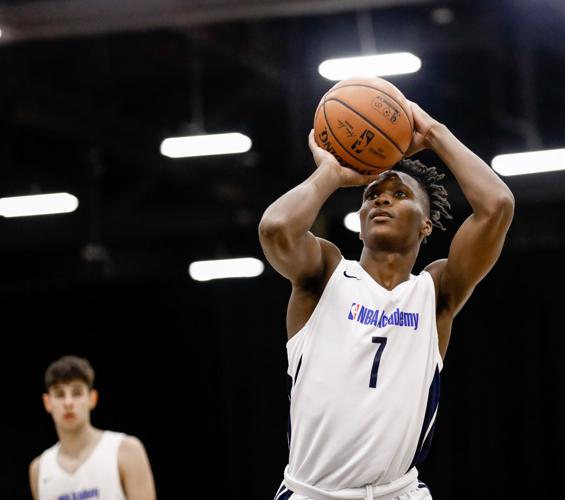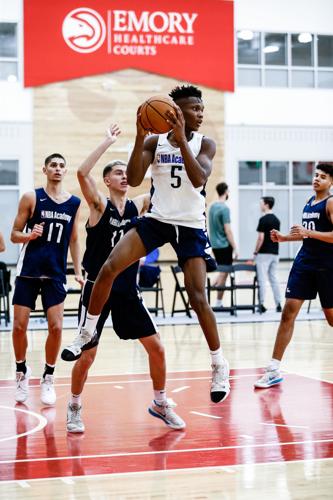Considering the MVP performance Bennedict Mathurin put up in a Canadian national youth tournament two years ago in British Columbia, the question wasn’t a surprise.
Nor was the answer.
Hernan Olaya, an assistant coach for the NBA Academy’s Latin America program, started chatting in Spanish with Mathurin’s Team Quebec coach after the event. He then turned toward the now-incoming Arizona freshman.
“He asked me where I was playing and what are my goals,” Mathurin said. “I said, ‘My goal is to make it to the NBA.’”
Of course, young prospects always say that. But there was something different about Mathurin, and not just his intriguing combination of skills, power and athleticism at 6 feet 6 inches and 190 pounds.
Mathurin also had a driving force that is still a factor today, helping him elevate through two years of NBA Academy development and into a four-star prospect who signed with the Wildcats last week.
It’s the memory, the words and the actions, of his then-15-year-old brother who was killed on a bicycle when Mathurin was just 12.
“My brother was like my best friend,” Mathurin said by phone from his hometown of Montreal. “I was always hanging out with him. My brother has always been there for me. He was playing basketball and was one of the best on his team and I just wanted to follow his steps.”
So when Olaya talked to Mathurin that day, leading to a later offer from the NBA Academy Latin America, there was no reason to hesitate.
Never mind that it would represent a huge leap of faith both on and off the court. Mathurin was the Latin America program’s first Canadian player. He spoke French, English and Creole … but not Spanish.
“It was hard,” Mathurin said. “People would try to talk to me and I couldn’t understand but on the court, it was pretty easy.
“When the coaches were talking, they were pointing with their fingers so I could understand. And a player translated for me, simple things like ‘screen’ that I couldn’t understand. I just had to learn to talk with people.”

The 6-foot-6 Bennedict Mathurin is a four-star prospect.
Communication, in whatever form, was essential to make the most of Mathurin’s raw talent.
Mathurin says he helped his basketball footwork and IQ from playing quarterback for a youth football team in Montreal. But his experience with Canada’s national winter sport was, well … let’s just say he was athletic and powerful back then, too.
“Hockey was different,” Mathurin said, chuckling. “I was skating fast but I didn’t know how to slow down, so I was always crashing into the glass.”
The same concept applied, to some degree, once Mathurin arrived in Mexico City. Mathurin said his game was mostly about “dunking and taking lobs” and that’s pretty much what his coaches saw.
“When he came in, he was able to get away with a lot of stuff with his athleticism,” said Walter Roese, head coach of the NBA Academy Latin America. “He could jump over people. It was easy for him to get to the basket.”
From there, Roese said, the academy worked toward building his understanding of team play and team defense, while shifting him from power forward to the wing. Last season, he even played point guard.
“He can play multiple positions,” Roese said. “He can score in different ways. He’s developed his own outside shot. Now he’s a hard kid to guard because he’s so explosive and he can create his own shot. I’m very proud of the way he developed and I give all the credit to him.”
It didn’t happen overnight. Mathurin spent the past two seasons with the NBA Academy, combining an intense basketball regimen with online coursework and extensive travel to play in tournaments all over the world. He also participating in a Basketball Without Borders camp and several other events.
“It really helped me be mature,” Mathurin said. “Sometimes I was flying by myself. Flying for every tournament, playing against different players at different levels, really helped my game.”
In Mexico, the NBA Academy Latin American club typically played about 28 local games against local college or pro teams and then flew out to play a number of international events each season.
Mathurin said the initial adjustment was tougher because he had to play power forward much of that first season because of an injury to a teammate.
“They told me to start doing screens and roll to the basket,” Mathurin said. “I was like, ‘No, I don’t want to do this because it isn’t part of my game.’ I feel like that’s the reason why I didn’t get big offers because I was not playing my position.
“But the year after that, I moved from (the) 4 to 1. I was playing the point guard. I was calling the plays. I think that really helped me a lot to get offers.”
By the end of his first Academy season, 2018-19, Mathurin’s stock was rising anyway. He participated in the NCAA’s Next Generation event during the 2019 Final Four, scrimmaging against five-star prospects such as Jalen Green and Josh Christopher on USA Basketball’s junior national team.
“I think I had like two 3s and a dunk” against them, Mathurin said. “At the time I was only 16 and they were 17 and 18.”
Three months later, Mathurin threw down 36 points despite a sore ankle in an NBA Academy Games competition in Atlanta. The college offers began to flood in. Mathurin continued to blow up in front of Arizona’s Sean Miller and Baylor coach Scott Drew at a Las Vegas event last December.
By that point, Mathurin had decided a stopover in college could help him get to points beyond basketball, whenever that might be.
“Yes, I can go pro, get some money and play basketball, Mathurin said. “But I feel the education was the thing I really needed to get. I wanted to have my degree in something because basketball is not forever.”
That sense of balance was drilled into Mathurin’s head from his mother, siblings and the NBA Academy experience alike. Mathurin said his mother moved from Haiti to study in Montreal and work in a hospital. His older sister, Jennifer, was an all-ACC academic pick at North Carolina State.
Then, in Mexico City, academics were very much a part of the daily grind. Roese said academy players take three hours of classes after breakfast, then work on development and conditioning in the early afternoon before going back to schoolwork between 3-6:30 p.m.
They’d practice starting at 7 p.m., then go back to study or rest. Lights out was at 11 p.m.
“It’s like a college life, you know?” Roese said. “They are very mature, very disciplined. Time management is something we always focus on.”
The Academy also provides assistance with physical therapy, conditioning, academics, and psychology. The structure reflects the NBA’s investment in international development that started with the Basketball Without Borders camp, of which several former Wildcats are alums: Lauri Markkanen, Deandre Ayton, Dusan Ristic, Josh Green, Emmanuel Akot, along with current Wildcat center Christian Koloko and incoming freshman guard Kerr Kriisa.
“We approach everything holistically,” said Chris Ebersole, a former Stanford walk-on who is now the NBA’s senior director of international basketball operations.
“We want to make sure the basketball is top notch and that we have the best possible coaching and training for skill development. But then that also extends to what the athletes are doing off the court physically and mentally.
“For us, it’s an investment in the growth of the game globally.”
Mathurin picked the Wildcats in mid-January, announcing his choice in French via a Montreal sports broadcast.
The love poured in, in direct texts and via social media — except from his Montreal basketball counterpart Luguentz Dort, the former ASU guard who had become a two-way player for Oklahoma City and its G League team.
Every time Mathurin would mention Arizona, he said, Dort would jokingly post a “forks up” in response.
In February, Mathurin had a chance instead to meet an NBA player from the Wildcats, when Markkanen was coaching at a Basketball Without Borders camp during the all-star break in Chicago.
This spring was supposed to be more of the same. Mathurin was scheduled to appear in another Final Four weekend event, then at the Nike Hoop Summit this month. All were canceled, of course, while Mathurin flew back to Montreal to ride out the coronavirus crisis and finished up his online high school courses.
So now, he’s back in the same city, near the same parks where he’d go one-on-one with his brother on so many days.
Yet now, whenever the COVID-19 crisis abates, Mathurin is going on to an even higher level of basketball than his brother was ever able to.
Which is exactly what Mathurin wanted to do.
“I was always like, ‘Do the stuff that he couldn’t do,’” he said. “I felt like he was — and always is — my motivation to go and achieve my dreams.”






